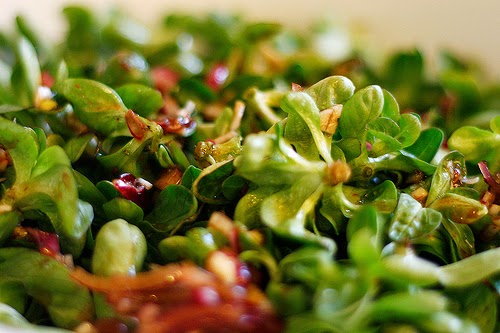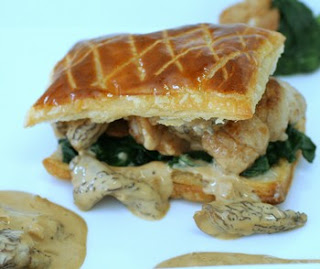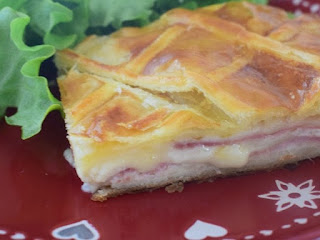from
Behind the French Menu
by
Bryan G. Newman
behindthefrenchmenu@gmail.com
Château d'Angers.www.flickr.com/photos/24736216@N07/6508320779/
Pike- Brochetwww.flickr.com/photos/biodivlibrary/6007967093/

Pâte a prunes aux mirabelles
A Mirabelle plum pie.
Photograph courtesy of JPC24M
www.flickr.com/photos/cjp24/37457471075/
Many dishes on Anjou menus will include Angevine wines. Anjou has over 35 different AOC/AOP wines. The most well-known include: Anjou Rouge, red; Anjou Gamay,a red wine best drunk young like a Nouveau Beaujolais; Anjou Villages, red; Cabernet d'Anjou, rose; Rosé d'Anjou, rose and Anjou Blanc, white. From the Anjou Saumur wines comes Cabernet de Saumur, rose; Coteaux de Saumur, a medium sweet white; Saumur-Champigny, red; Cabernet de Saumur, rose; Crémant de Loire sparkling white and rose wines.

An Anjou white.
Photograph courtesy of Dale Cruse
www.flickr.com/photos/dalecruse/9621891309/
Add to Anjou’s AOP wines the mostly excellent, and inexpensive, IGP Val de Loire wines and you will be overwhelmed with the choice. If you have a problem choosing, then there are quite a number of wine roads in Anjou. They will guide you to local wineries that have tastings. Each route covers a number of different appellations. The routes will also take you past farms offering local cheeses and other products, and, of course, to restaurants. NB: The wine tastings require a small donation to the local economy! Contact the local French Government Tourist Information Office in your home country for the maps before you leave home.
Also, see the Anjou Tourist Information English Language website:
Sainte-Maure
de Touraine AOP with the straw showing.
Photograph courtesy of Fromagerie Bale
--------------------------------
Behind the French Menu
by
Bryan G. Newman
behindthefrenchmenu@gmail.com
Copyright 2010, 2015, 2018, 2020 -------------------------------- Are you searching for words, names,or phrases on French Menus? Just add the word, words, or phrase that you are searching for to
the words "Behind the French Menu" and search with Google. Behind the
French Menu’s links include hundreds of words, names, and phrases that are seen
on French menus. There are over 400 articles that include over 3,000 French dishes
with English translations and explanations. ------------------ Connected Posts:
AOC and AOP on France's Foods and Wine labels? Why is the AOC becoming an AOP?
Á la Moelle – Dishes Served With or Flavored With Bone Marrow. Á la Moelle on French Menus.
Agen in South-west France. Home to the gold standard in prunes. This pretty and walkable town is surrounded by castles and Chateaus and some the prettiest villages in France
Ail - Garlic. Garlic in French Cuisine.
Alose or Grande Alose; Shad or Allis Shad on French Menus.
Anguille, Anguille d'Europe - Freshwater Eels in French Cuisine.
Brochet - Pike, the Fish. Pike in French Cuisine
Cockels, Mussels and Conches, Then Snails will not be Strange.
Cremants are the best value in French sparkling wines.
Escargots - Snails on French Menus and How to Order Snails in France. If You Enjoy
Échalotes - Shallots. Shallots on French Menus. Shallots are One of the Most Important Herbs in the French Kitchen
Foie Gras - Fattened Goose or Duck Liver. Foie Gras on French Menus. Foie Gras in French Cuisine.
France's Butter Sauces I. The Three Most Popular Butter Sauces on French Menus.
Freshwater Perch; Seeking out France’s Tastiest Freshwater Fish. Freshwater Fish in France II.
Frog's Legs - Cuisses de Grenouilles on French Menus.
Jambon
Sec (Cru) - Air-Cured Ham. The Ten Most Popular Air-Cured Hams on French Menus.
La Dinde, the Tasty Turkey on a French Menu-
Lamprey in French cuisine.
Mâche – Lamb's Lettuce or Corn Salad. Lamb's Lettuce in French Cuisine.
Magret de Canard or Lou Magret. - Duck Breast on French Menus.
Montmorency Cherries on French Menus. Camille Pissarro and Jean-Jacques Rousseau, who made the village of Montmorency internationally famous.
Nantes. The City and its Cuisine. A Wonderful Place to Visit and a Wonderful Place to Dine.
Pintade, the Guinea Hen, may be on Your French Menu; it Makes a Pleasant Change From Chicken.
Organic Food in France. Organic Produce, Meats, Milk, Cheeses, Wines and More.
Sainte-Maure de Touraine AOC. The Sainte-Maure de Touraine Cheese. Sainte-Maure de Touraine is One of France's Finest Goat's milk cheeses
Salmon, Atlantic Salmon – Saumon on French Menus
Sandre - Zander in the USA and Pike Perch in the UK. Sandre in French Cuisine.
Taureau de Camargue AOC.AOP. Choose from Among the Best Beef Cattle in France.
Tomate – Tomato. France’s Greatest Tomato, the Tomate de Marmande AOC. The Tomato in French Cuisine.
The Apricot or Abricot. The Wonderful Fruits of France.
The Carmague, France. The Land, its People and its Own Unique Cuisine.
The Greengage Plum, the Reine-Claude Plum in French cuisine.
The Mousseron or St. George's Mushroom, The Wonderful Wild Mushrooms of France II.
The New French Wine Labels. What has changed in French wines? What is an AOP, an IGP and a Vin de France.
The Tastiest Chickens and Other Poultry in France - The Volailles Fermières Label Rouge
Vinegar, Vinaigrette and Verjus in French Cuisine.





















